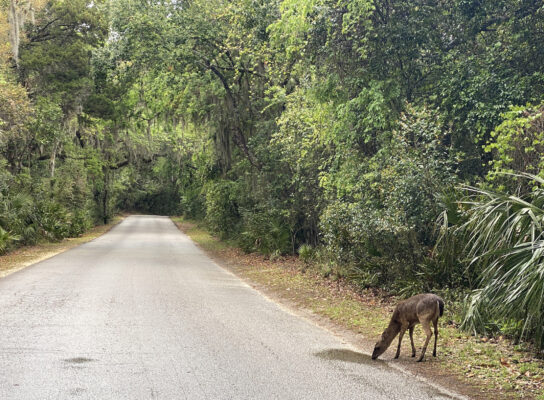By Pat Foster-Turley

Here on Amelia Island, deer cannot be legally hunted, and for the deer, that’s a good thing. But it’s not a sure guarantee that they will live a long, healthy life here. For years, with the ebb and flow of populations of natural predators like bobcats and coyotes, there have been times when some local naturalists believe that they have spread beyond the carrying capacity of the island and will suffer death by disease or starvation. But that does not seem to be the case. There are other causes of deer mortality on our island, too.
The largest cause of deer death seems to be our roads. The deer here are not wary of cars and roads, as any drive through Fort Clinch State Park will illustrate. Most every day, Bucko and I drive through the park, and most every day, we see deer on the road, seemingly oblivious to cars and people. In the park with low speed limits and most people looking out for nature, this hasn’t seemed to be a problem. But outside of the park, where many deer eventually spread, danger lurks. Twice now, Bucko and I have been involved in deer deaths. Once, a number of years ago, Bucko was leaving his shift as a ranger at Fort Clinch State Park and driving along Atlantic Avenue around dusk when a doe ran across the road, smack into the side of his pickup truck. A couple of thousand dollars later, the vehicle was fine, but the deer was found dead in a ditch a few days later.

Another morning, Bucko summoned me to our backyard to look at my butterfly garden. “Come on out here and take a look!” I dutifully went over to look at the garden, saw some flowers in bloom, and was surprised that Bucko was interested. It was only when he directed my gaze that I saw what he was referring to. There was a dead deer hidden in the brush! Apparently, it was yet another roadkill that managed to stagger into our yard to die. Not a fun way to start the day for me, and certainly not for the deer. Who knows how many other deer accidents have happened here to others besides us?
And then there are the predators. Although our bobcat population seems to have shrunk for no apparent reason, they have left a niche that coyotes have filled. There are times when people report lots of coyote sightings and times like now when there are fewer. But they are always here, it seems. Amy Beach, who is a close chronicler of the deer in Fort Clinch State Park, has seen a number of fawns disappear, most likely due to predation. Besides in the park, coyotes have been seen patrolling their territories around the golf courses, airport strip, and neighborhoods around the Egans Creek Greenway. Although smaller prey like raccoons, opossums, and cats (keep your cats inside!) are their most usual prey, small or weak deer must figure into their diet, too.

The most amazing cause of death of our local deer just came to light in a rare occurrence a couple of months ago. Circling vultures led some hikers on the Greenway to a spot where two large buck deer were found dead, with their antlers locked together. Bucks fight each other for dominance and access to females when they are in rut. These two big fellows had a fight to the death. They got stuck together and couldn’t extricate themselves, and died locked together in a muddy bog off the trail. I’ll spare you the full gruesome sight, but the locked antlers tell the story clearly enough.

At least Bucko and I know that “Bucko” the buck was not one of the casualties. According to Amy, who named him years ago when she first met Bucko the ranger, this magnificent and now old deer still reigns in the park. At some point, he will die a natural death due to old age and infirmity, a fate that those deer lucky enough to escape cars and coyotes will succumb to themselves at some point, too.
For now, it looks like the deer population is thriving and that natural and unnatural causes are keeping their population in check. But the moral of the story is: be careful when driving here. We may seem like an urban area, but with all our yards and flowers and grasses, this world is a good place for them, too. Don’t you, too, end up with a deer-related accident. It’s no fun, for sure.
Pat Foster-Turley, Ph.D., is a zoologist on Amelia Island. She welcomes your nature questions and observations. [email protected]
